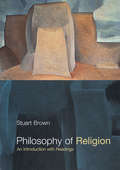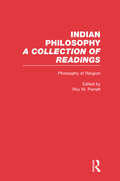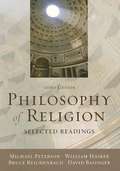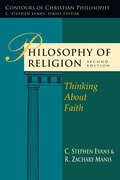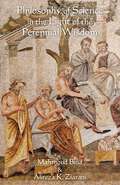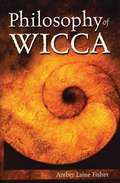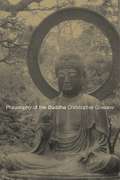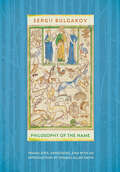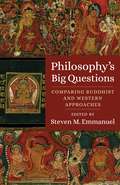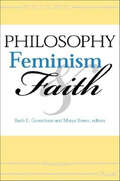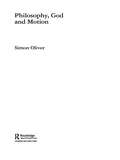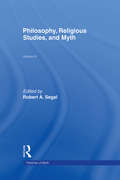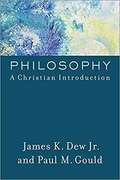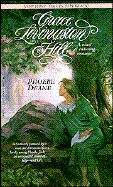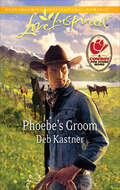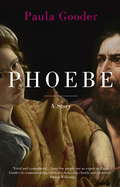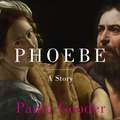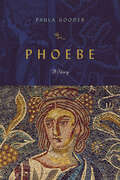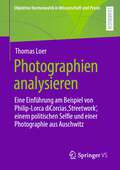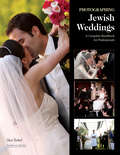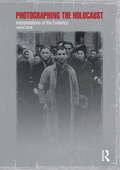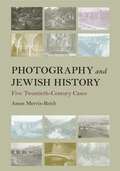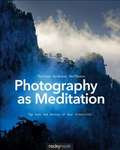- Table View
- List View
Philosophy of Religion: An Introduction with Readings (Philosophy and the Human Situation)
by Stuart BrownWith the entry-level student in mind, Stuart Brown guides the reader through three main topics: whether or not there is life after death; whether or not there is a powerful, beneficent intelligence controlling the universe; and the nature and appropriate defence of religious belief or faith. Each chapter is linked to readings by commentators on religion and belief, such as David Hume, John Hick, Richard Dawkins and William James. Key features also include activities and exercises, chapter summaries and guides to further reading.
Philosophy of Religion: Indian Philosophy (Indian Philosophy Ser. #Vol. 4)
by Roy W. PerrettFirst Published in 2001. Routledge is an imprint of Taylor & Francis, an informa company.
Philosophy of Religion: Selected Readings
by William Hasker Michael Peterson Bruce Reichenbach David BasingerThe new edition of this perennially popular anthology in the philosophy of religion examines both basic classical concepts and a host of contemporary issues. Organized into fourteen thematic sections, Philosophy of Religion presents seventy-three selections that cover standard subjects--religious experience, theistic arguments, the problem of evil, and miracles--as well as more recent topics including reformed epistemology, process theism, the kalam theological argument, the religion-science controversy, religious ethics, and the diversity of world religions. The third edition adds two new sections--on the ontological status of religion and open theism--along with helpful study questions and a glossary. It also features revised and expanded section introductions and updated suggestions for further reading. While it deals primarily with the Western and analytic traditions in philosophy, Philosophy of Religion, Third Edition, also incorporates readings representing continental, feminist, and Asian perspectives. New selections include essays by Marilyn McCord Adams, Robert Merrihew Adams, David Basinger, Emile Durkheim, C. Stephen Evans, J. R. Lucas, Bruce Reichenbach, and Jean-Paul Sartre. An ideal stand-alone textbook for courses in the philosophy of religion, this volume is also readily compatible for use as a primary source reader in conjunction with a secondary text.
Philosophy of Religion: Thinking About Faith (Contours of Christian Philosophy)
by C. Stephen Evans R. Zachary ManisAdd this ebook to your cart, purchase it and download it immediately in any or all of these formats: PDF.Philosophy of Religion
Philosophy of Science in the Light of the Perennial Wisdom
by Mahmoud Bina Alireza K. ZiaraniBacked by its technological achievements, modern science appears as the de facto source of truth to the majority of our contemporaries. Its sole reliance on reason and empirical data gives it an air of objectivity that has conferred upon it an almost unquestioning authority. Against the backdrop of this pervasive scientism, Philosophy of Science in the Light of the Perennial Wisdom is a daring attempt to offer an intellectual critique of modern science in its foundation by rigorously examining the intrinsic limitations of rational thought and empirical investigation. Unique of its kind, this book offers a refreshing look at the traditional doctrines of epistemology and metaphysics as an antidote to the subjective as well as objective errors of modern science, which is thus revealed as no more than a belief system that falls radically short of offering a full knowledge of reality; this, in contrast to the perennial wisdom of the world's great religions that for millennia have offered humankind not only keys to true knowledge, but also the means of attaining it, which precisely constitutes man's reason for being.
Philosophy of Wicca
by Amber Laine FisherThis book examines and analyzes the philosophy of Wicca, and among other things discusses how Wiccans can interact with mainstream religions. Other topics include why nature is important in Wicca, an examination of the Wiccan Rede and why balance is so important in the practice of Wicca.
Philosophy of the Buddha: An Introduction
by Christopher GowansPhilosophy of the Buddha is a philosophical introduction to the teaching of the Buddha. It carefully guides readers through the basic ideas and practices of the Buddha, including kamma (karma), rebirth, the not-self doctrine, the Four Noble Truths, the Eightfold Path, ethics, meditation, non-attachment, and Nibbâna (Nirvana).The book includes an account of the life of the Buddha as well as comparisons of his teaching with practical and theoretical aspects of some Western philosophical outlooks, both ancient and modern. Most distinctively, Philosophy of the Buddha explores how Buddhist enlightenment could enable us to overcome suffering in our lives and reach our full potential for compassion and tranquillity.This is one of the first books to introduce the philosophy of the Buddha to students of Western philosophy. Christopher W. Gowans' style is exceptionally clear and appropriate for anyone looking for a comprehensive introduction to this growing area of interest.
Philosophy of the Name (NIU Series in Orthodox Christian Studies)
by Sergii BulgakovThis is the first English translation, by Thomas Allan Smith, of Philosophy of the Name (Filosofiia imeni). Sergii Bulgakov (1871–1944) wrote the book in response to a theological controversy that erupted in Russia just before the outbreak of World War I. Bulgakov develops a philosophy of language that aims to justify the truthfulness of the statement "the Name of God is God himself," a claim provoking debate on the meaning of names, and the Name of God in particular. Philosophy of the Name investigates the nature of words and human language, considers grammar and parts of speech, and concludes with an exposition on the Name of God.Name-glorifying, a spiritual movement connected with the Orthodox practice of the Jesus Prayer, was initially censured by the Holy Synod of the Russian Orthodox Church, and the controversy raised profound questions that continue to vex ecclesiastical authorities and theologians today. The controversy exposed a vital question concerning the ability of human language to express experiences of the Divine truthfully and authentically. Bulgakov examines the idea that humans do not create words, rather, objects speak their word to human beings, and words are the incarnation of thought in a sonic body conveying meaning.Philosophy of the Name offers a philosophy of language for contemporary theologians of all confessions who wrestle with the issue of language and God. It is a persuasive apologia for the mysterious power of words and an appeal to make use of words responsibly not only when speaking about God but equally when communicating with others.
Philosophy of the State as Educator
by Fr. Thomas DubayPenetrating analysis of questions like: What is the function of the state in education? What obligations does the state have to support private education? Must the state teach morality?
Philosophy's Big Questions: Comparing Buddhist and Western Approaches
by Dan Arnold Jan Westerhoff Rick Repetti Amber D. Carpenter Douglas S. Duckworth Stephen J. Laumakis Peter HershockCertain questions have recurred throughout the history of philosophy. They are the big questions—about happiness and the good life, the limits of knowledge, the ultimate structure of reality, the nature of consciousness, the relation between causality and free will, the pervasiveness of suffering, and the conditions for a just and flourishing society—that thinkers in different cultures across the ages have formulated in their own terms in an attempt to make sense of their lives and the world around them.The essays in this book turn to the major figures and texts of the Buddhist tradition in order to expand and enrich our thinking on these enduring questions. Examining them from a comparative and cross-cultural perspective demonstrates the value of alternative ways of addressing philosophical problems, showing how different approaches can produce new and unexpected kinds of questions and answers. Engaging with the Buddhist tradition, this book shows, helps return philosophy to its practical as well as theoretical aim: not only understanding the world but also knowing how to live in it.Featuring striking and generative comparisons of Buddhist and Western thought, Philosophy’s Big Questions challenges our thinking in fundamental ways and offers readers new conceptual tools, methods, and insights for the pursuit of a good and happy life.
Philosophy, Feminism & Faith (Philosophy of Religion)
by Marya Bower Ruth E. Groenhout"The stories are powerful, sometimes heart-rending, sometimes lyrical, but always deeply personal. And there is some very good philosophizing as part of the bargain." —Merold WestphalHow can the seemingly separate lives of philosopher, feminist, and follower of a religious tradition come together in one person's life? How does religious commitment affect philosophy or feminism? How does feminism play out in religious or philosophical commitment? Wrestling with answers to these questions, women who balance philosophy, feminism, and faith write about their lives. The voices gathered here from several different traditions—Catholic, Protestant, Quaker, Jewish, and Muslim—represent diverse ethnicities, races, and ages. The challenging and poignant reflections in Philosophy, Feminism, and Faith show how critical thought can successfully mesh with religious faith and social responsibility.
Philosophy, God and Motion (Routledge Radical Orthodoxy)
by Simon OliverIn the post-Newtonian world motion is assumed to be a simple category which relates to the locomotion of bodies in space, and is usually associated only with physics. This book shows this to be a relatively recent understanding of motion and that prior to the scientific revolution motion was a broader and more mysterious category, applying to moral as well as physical movements. Simon Oliver presents fresh interpretations of key figures in the history of western thought including Plato, Aristotle, Aquinas and Newton, examining the thinkers’ handling of the concept of motion. Through close readings of seminal texts in ancient and medieval cosmology and early modern natural philosophy, the books moves from antique to modern times investigating how motion has been of great significance within theology, philosophy and science. Particularly important is the relation between motion and God, following Aristotle traditional doctrines of God have understood the divine as the ‘unmoved mover’ while post-Holocaust theologians have suggested that in order to be compassionate God must undergo the motion of suffering. The text argues that there may be an authentically theological, as well as a natural scientific understanding of motion. This volume will prove a major contribution to theology, the history of Christian thought and to the growing field of science and religion.
Philosophy, Religious Studies, and Myth: Volume III (Theorists of Myth #Vol. 3)
by Robert A. SegalMuch of the theorizing about myth in philosophy and religious studies grows out of efforts to understand the classics and the Bible. In the case of the classics, the presence of myth has been taken for granted, and conclusions reached about Greek and Roman mythology have spurred generalizations about myth. In the case of the Bible, however, the existence of myth has been contested. In fact, Judaism and Christianity are regularly praised for their nonmythic outlook. Conclusions reached about the presence or absence of myth in either the Hebrew Bible or the New Testament have led to generalizations about myth per se. Many of the essays in this volume apply theories of myth to classical, biblical, and ancient Near Eastern cases, but in so doing they draw conclusions about the nature of myth itself. Those essays that criticize past applications make generalizations as weIl. By no means has aIl theorizing about myth from philosophy and religious studies centered on the ancient world, and this volume contains selections from theories in both disciplines that stern from reflections on the nature of science, language, knowledge, and reality.
Philosophy: A Christian Introduction
by Paul M. Gould James K. Jr DewTwo experienced educators offer an up-to-date introduction to philosophy from a Christian perspective that covers the four major areas of philosophical thought: epistemology, metaphysics, philosophy of religion, and ethics. <p><p> Written from an analytic perspective, the book introduces key concepts and issues within the main areas of philosophical inquiry in a comprehensive yet accessible way, inviting readers on a quest for goodness, truth, and beauty that ultimately points to Jesus as the source of all.
Phoebe Deane (Grace Livingston Hill Series #88)
by Grace Livingston HillBeautiful young Phoebe was desperate! Cruel and cunning Hiram Greene had declared his intention to marry her. At first, Phoebe didn't take Hiram seriously. After all, he couldn't force her into marriage. Then Hiram launched a shrewd campaign of deceit and lies about Phoebe. Soon everyone around her, even her family, seemed determined to make her give in to Hiram. Could she stop what Hiram had started before it was too late? Or would she lose everything--her freedom, her happiness, and her wonderful new friendship with handsome Nathaniel Graham? Grace Livingston Hill is the beloved author of more than 100 books. Read and enjoyed by millions, her wholesome stories contain adventure, romance, and the heart-warming triumphs of people faced with the problems of life and love. There are ninety books by Grace Livingston Hill in the Bookshare collection with the rest on the way.
Phoebe's Groom (Email Order Brides Ser. #1)
by Deb KastnerThe smell of cinnamon buns and apple pie remind widowed dad Chance Hawkins of the wife he lost five years ago. As does his sad-eyed little girl. So when his aunt hires a new pastry chef- whom she finds online-for their family-owned Texas café, the cowboy cook grumbles. What's more, fancy baker Phoebe Yates is boarding in their home. But soon enough, kind Phoebe is reminding Chance how nice it is to share a sweet roll with his daughter before school. And maybe opening his heart to becoming a groom again!
Phoebe: A Story
by Paula GooderSometime around 56 AD, the apostle Paul wrote to the church in Rome. His letter was arguably his theological masterpiece, and has continued to shape Christian faith ever since. He entrusted this letter to Phoebe, the deacon of the church at Cenchreae; in writing to the church that almost surely met in her home, Paul refers to her both as a deacon and as a helper or patron of many. But who was this remarkable woman? In this, her first novel, Biblical scholar and popular author and speaker Paula Gooder tells Phoebe's story - who she was, the life she lived and her first-century faith - and in doing so opens up Paul's theology, giving a sense of the cultural and historical pressures that shaped Paul's thinking, and the faith of the early church. Written in the gripping style of Gerd Theissen's The Shadow of the Galilean, and similarly rigorously researched, this is a novel for everyone and anyone who wants to engage more deeply and imaginatively with Paul's theology - from one of the UK's foremost New Testament scholars.
Phoebe: A Story
by Paula GooderSometime around 56 AD, the apostle Paul wrote to the church in Rome. His letter was arguably his theological masterpiece, and has continued to shape Christian faith ever since. He entrusted this letter to Phoebe, the deacon of the church at Cenchreae; in writing to the church that almost surely met in her home, Paul refers to her both as a deacon and as a helper or patron of many. But who was this remarkable woman? In this, her first work of fiction, Biblical scholar and popular author and speaker Paula Gooder tells Phoebe's story - who she was, the life she lived and her first-century faith - and in doing so opens up Paul's theology, giving a sense of the cultural and historical pressures that shaped Paul's thinking, and the faith of the early church. Written in the gripping style of Gerd Theissen's The Shadow of the Galilean, and similarly rigorously researched, this is a book for everyone and anyone who wants to engage more deeply and imaginatively with Paul's theology - from one of the UK's foremost New Testament scholars. (P) Hodder & Stoughton Ltd
Phoebe: A Story
by Paula GooderSometime around 56 AD, the apostle Paul wrote to the church in Rome. He entrusted this letter to Phoebe, whom he describes as the deacon of the church at Cenchreae and a patron of many. But who was this remarkable woman? Biblical scholar and popular author and speaker Paula Gooder imagines Phoebe's story—who she was, the life she lived, and her first-century faith—and in doing so opens up Paul's world, giving a sense of the cultural and historical pressures that shaped his thinking and the faith of the early church. After the narrative, Gooder includes an extensive notes section with comments on the historical context, biographical details, cultural practices, and more. Rigorously researched, this is a book for anyone who wants to engage more deeply and imaginatively with Paul's theology.
Photographien analysieren: Eine Einführung am Beispiel von Philip-Lorca diCorcias ‚Streetwork‘, einem politischen Selfie und einer Photographie aus Auschwitz (Objektive Hermeneutik in Wissenschaft und Praxis)
by Thomas LoerDer vorliegende Band führt am Beispiel von drei vom Typus, vom Entstehungs- und vom Verwendungszusammenhang her unterschiedlichen Photos aus verschiedenen Forschungszusammenhängen detailliert in die objektiv-hermeneutische Analyse von Photographien ein. Dabei werden auch Konstitutionstheorie und Methodologie so dargestellt, dass die Arbeit mit der Forschungsmethode Objektive Hermeneutik und ihr Erlernen fundiert und fasslich möglich sind. Dem für die Methode zentralen Prinzip der Sachangemessenheit folgt der Band, indem bei der Auswertung der Photographien materiale Fragestellungen bearbeitet werden: (A) die Rekonstruktion neutraler Reziprozität (ähnlich der zivilen Unaufmerksamkeit gemäß Erving Goffman), (B) die Rekonstruktion der politischen Kommunikation via Selfies als eines eigenen Typus der Kommunikation und (C) die Rekonstruktion einer Praxis, von der Georges Didi-Huberman mit Recht sagt, dass sie alle Anthropologie übersteigt. Die Darlegung setzt bei der Planung der Forschung an, behandelt die Fragen der Fallauswahl, der Selektion des Datentypus und der Erhebung, die spezifischen Fragen der Analyse von Photographien und die besondere Form der Ergebnisdarstellung. Eine Liste publizierter objektiv-hermeneutischer Photographieanalysen und ein Glossar zu Begriffen der Objektiven Hermeneutik ergänzen die Darstellung.Mit Exkursen……zu Begriff und Terminus der Interpretation…zur Frage von Sichtbarkeit, Notation und Beschreibung…zum Begriff der strukturellen Reziprozität…zu den Begriffen der Normalität und der Normalisierung…zum Phänomen der Bestattung
Photographing Jewish Weddings: A Complete Handbook for Professionals
by Stan TurkelA guide to the culture and traditions of Judaic ceremonies and receptions, this study offers photographers insight and advice for targeting and capturing Jewish weddings. Time lines and schedules are discussed with examples of start-to-finish wedding-day festivities, and a list of the essential images for the different types of weddings#151;such as Orthodox, Hasidic, Modern, Reform, and Conservative#151;emphasize the key elements photographers are not to miss. A special #147;Marketing 101 for Jewish Weddings” section helps photographers reach these potentially lifelong clients and reveals how these weddings, which sometimes fall on weekdays, can boost sales.
Photographing the Holocaust: Interpretations of the Evidence
by Janina StrukAtrocities committed by the Nazis during the Holocaust were photographed more intensely that any before. In the time since the images were taken they have been subjected to a perplexing variety of treatments: variously ignored, suppressed, distorted and above all exploited for propaganda purposes. With the use of many photographs, including some never before seen, this book traces the history of this process and asks whether the images can be true representations of the events they were depicting. Yet their provenance, Janina Struk argues, has been less important that the uses to which a wide range of political interests has put them, from the desperate attempts of the war-time underground to provide hard evidence of the death camps to the memorial museums of Europe, the US and Israel today.
Photography and Jewish History: Five Twentieth-Century Cases (Jewish Culture and Contexts)
by Amos Morris-ReichIt is a sign of the accepted evidentiary status of photographs that historians regularly append them to their accounts, Amos Morris-Reich observes. Very often, however, these photographs are treated as mere illustrations, simple documentations of the events that transpired. Scholars of photography, on the other hand, tend to prioritize the photographs themselves, relegating the historical contexts to the background. For Morris-Reich, however, photography exists within reality; it partakes in and is very much a component of the history it records. Morris-Reich examines how photography affects categories of history and experience, how it is influenced by them, and the ways in which our understanding of the relationship between history and photography can be theorized and reoriented.Morris-Reich here turns to five twentieth-century cases in which photography and Jewish history intersect: Albert Kahn’s utopian attempt to establish a photographic archive in Paris in order to advance world peace; the spectacular failed project of Helmar Lerski, the most prominent photographer in British Mandate Jewish Palestine; photography in the long career of Eugen Fischer, a Nazi professor of genetics; the street photography of Robert Frank; and the first attempt to introduce photography into the study of Russian Jewry prior to World War I, as seen from the post-Holocaust perspective of the early twenty-first century. Illustrated with nearly 100 images, Photography and Jewish History moves beyond a focus on Jewish photographers or the photographic representation of Jews or Jewish visibility to plumb the deeper and more significant registers of twentieth-century Jewish political history.
Photography as Meditation
by Torsten Andreas HoffmannFor many people, photography serves as a form of meditation; a way to separate themselves from their stressful lives. In this book, Torsten Andreas Hoffmann explores an approach to artistic photography based on Japanese Zen-Philosophy. Meditation and photography have much in common: both are based in the present moment, both require complete focus, and both are most successful when the mind is free from distracting thoughts. Hoffman shows how meditation can lead to the source of inspiration.Hoffman's impressive images of landscapes, cities, people, and nature, as well as his smart image analysis and suggestions about the artistic process, will help you understand this approach to photography without abandoning the principles of design necessary to achieve great images. Photographing busy scenes, especially, requires an inner calm that enables you to have intuition for the right moment and compose a well-balanced image amidst the chaos.The goal of this book is to develop your photographic expression. It provides enrichment for photographers who believe that only technical mastery produces great images and shows how important it is to engage with your own awareness to act creatively.
